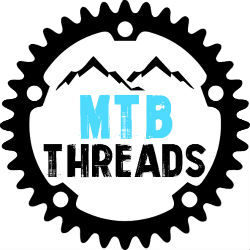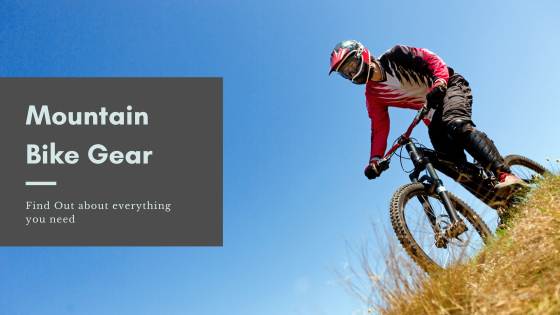Mountain Bike Gear: What Do You Need?
Mountain biking comes with a vast range of paraphernalia. But what do you need, but what do you need when it comes to mountain bike gear, and where can you save money?
Bikes aside, in this post, I’ll give you the lowdown on what you need for a day on the trails. You’ll learn about the best options and what to avoid. Let’s get into it!
A Mountain Bike Helmet

A mountain bike helmet is probably the most essential piece of kit you need. There are a few different types of mountain bike helmets to suit various riding styles; therefore, you need to choose the correct one for you.
For example, if you are a downhill rider or ride very technical terrain, you will need the coverage of a full-face helmet. Alternatively, a good open-face helmet will be fine if you’re a trail rider.
A mountain bike helmet is one of those things you don’t want to scrimp on. As with most things, you get what you pay for, and higher-end helmets offer more features, comfort, and protection. But your helmet also needs to fit your head correctly. An ill-fitting mountain bike helmet is dangerous and can be incredibly uncomfortable.
Check out my guide to mountain bike helmets for the whole story.
Mountain Bike Clothing
Proper mountain bike clothing isn’t just to make you look cool; it is functional. Mountain bike jerseys and shorts keep you comfortable and allow you to perform at your best. If you were to ride with an old T-shirt and board shorts, you’d get uncomfortable as soon as you start sweating or if it rains.
There’s an old saying in survival circles, “Cotton kills.” This comes from the fact that cotton takes a long time to dry, making you cold. In extreme circumstances, remaining wet in the outdoors can cause hypothermia.
Mountain bike clothing is made from technical fabrics that draw moisture away from your skin and dry quickly. Therefore, your body can regulate its temperature, even when you’re pedaling hard on a steep climb.
Mountain bike jerseys and shorts are stretchy and shaped to allow freedom of movement. You’ll be surprised how effective the designs of mountain bike clothing are.
I recommend that you buy padded shorts or liners. These come with a cushioned section that alleviates pressure from your saddle. You certainly notice the difference when you don’t have any cushioning.
Check out my mountain bike clothing content for more information.
Mountain Bike Gloves
Not every rider wears mountain bike gloves, but I prefer to. Gloves help you to grip the handlebars, even when it’s raining or you have sweaty hands. On top of this, they give you a bit more protection if and when you crash.
Here is my guide to mountain bike gloves and some recommendations.
Mountain Bike Shoes

The grip and comfort provided by proper mountain bike shoes are unmatched. However, if you’re on a budget or just starting out, you can ride in flat shoes like skate shoes. They won’t give you the protection and shock absorption of mountain bike shoes, but they should grip your pedals reasonably well.
Avoid riding in hiking shoes or anything with very thick soles. These shoes are rugged and often waterproof but isolate you from valuable feedback through the pedals.
You may opt for clipless pedals, which require special shoes. This shoe-pedal combo attaches you to your bike, giving you some advantages, including more efficient pedaling and security. But they aren’t for everyone, but you can learn all about the various types of pedals here.
Here are my articles on the various mountain bike shoes available.
Knee And Elbow Pads
I feel vulnerable riding without knee and elbow pads. Like helmets, you can buy pads to suit your riding style. For instance, I wear full knee and shin guards when riding technical terrain or in the bike park. On the other hand, when I’m just going for a local pedal, I wear lightweight pads. These offer less protection but are less bulky and more comfortable.
I wear the IXS Hack elbow pads for all my rides, as they are so comfortable while offering plenty of protection. Here is my review of the IXS Flow knee pads.
Eyewear
Covering your eyes while mountain biking is pretty essential. It’s common to get a face full of mud and flies hitting you in the face, even if you wear a full-face helmet.
If you ride with an open-face helmet, you’ll want to protect your eyes with a good pair of MTB or cycling glasses. Riding in forests and on dull days requires clear lenses, but you can often swap the lenses for darker ones on sunny days.
When I ride in my full-face helmet, I’ll always wear goggles. They provide extra coverage and stay in place when the trails get bumpy.
Wet-Weather Mountain Bike Gear

If you ride somewhere that gets soggy, you’ll want some good wet-weather mountain bike gear. Look for waterproof shorts or pants to add comfort to your wet-weather rides and a jacket.
You can spend lots of money on waterproof mountain bike jackets, but you don’t have to go silly if you don’t want to. Buying an expensive jacket that will sit in your backpack until it rains and then get covered in mud isn’t appealing. However, there are some great options in my guide.
Tools To Keep You Riding
Tools are essential mountain bike gear as bikes break occasionally. But there are a few things you can carry that will keep you riding or get you home.
Punctures are inevitable, even if you go tubeless. Therefore, I always carry a spare inner tube, a pump, and tire levers. I also like to carry a multi-tool, which allows me to fix most problems at the trailside. My guide explains what to look for in a good mountain bike multi-tool.
Backpack/Hydration Pack/Hip Pack

I always go for a ride with something to carry: water, tools, extra clothing, etc. I usually ride with a backpack, but I wear a hip pack when going for local rides. A great alternative is a hydration pack; these are smaller and more lightweight but still have great carrying capacity.
Some backpacks and hydration packs have built-in back protectors. These give you more confidence on the trails and peace of mind if you crash.
Final Thoughts On Mountain Bike Gear
As you can see, there is quite a lot of mountain bike gear to buy. However, you don’t have to buy all of it at once. Ensure you have a good helmet, a decent jersey and shorts, and everything you need to repair a puncture. The other stuff will come later, and you’ll soon realize what you need to buy next after a few rides.
Please let me know in the comments section below if you have any questions or questions.




